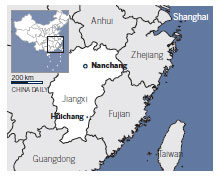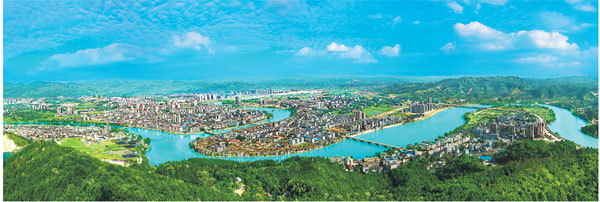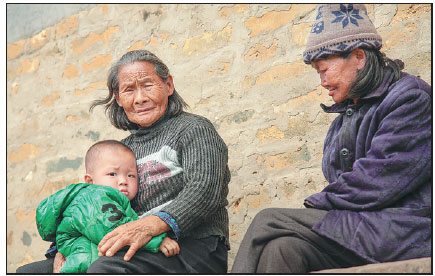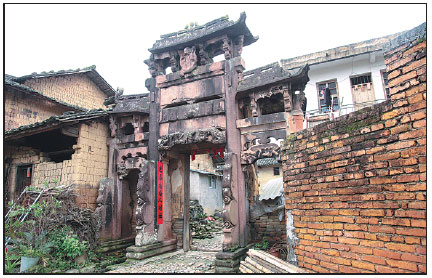County eyes prosperity through tourism
Updated: 2016-06-16 07:50
By Zhao Huanxin In Huichang, Jiangxi Province(China Daily)
|
|||||||||
Editor's note: For many foreigners traveling in China for the first time, the country's sheer size and uneven development can be both baffling and bewildering. The world's second-largest economy boasts a per capita GDP of $8,000, yet at least 70 million people are still living in absolute poverty, earning less than the official poverty line of 2,300 yuan ($361) a year. On the affluent east coast, boys and girls are scampering for coveted tickets to Shanghai Disneyland, which is scheduled to open in mid-June. But hundreds of miles west are broad swathes of barren mountainous areas, where some schoolchildren have to use rope ladders to scale 800-meter cliffs just to get to school. The central government wants all those living in China to at least have adequate food and clothing plus access to education, basic medical services and housing. The money and manpower mobilized for this endeavor must precisely target those in need. Hence the vision of "taking targeted measures in poverty alleviation", as President Xi Jinping said last year. With this vision, Xi has pledged to lift all the remaining poor - 70 million - out of their plight within five years. Like many government agencies, organizations and businesses in Beijing and beyond, China Daily has also been engaged in this poverty-relief campaign over the years. In several batches, we have sent staffers to Dongxiang county in Northwest China's Gansu province, and Huichang county in East China's Jiangxi province. These two regions are among the most vulnerable to the specter of poverty. We have helped them carry out development projects and train teachers for local schools. But most often, we've dispatched reporters, in teams of two and three, to tell the stories of the grassroots regions. These reporters spend several weeks in a county with farmers, chronicling their everyday life and how the local cadres help the residents lift themselves out of poverty. From today, we will publish a series of reports on Huichang county, a land that is rarely seen by foreigners yet abundant with untold stories.
|
A panaromic view of Huichang county in Jiangxi province. Li Jianping / For China Daily |
A chance to experience life in a military castle built nearly 550 years ago, an excursion to rugged mountain vistas high up in the pristine air and a glimpse of a vibrant county striving to break free of poverty.
This is what Huichang, in Jiangxi province, promises visitors - a haven for curious tourists who are tired of the crowds.
It is said that the county got its name in AD 982 during the Northern Song Dynasty (960-1127), when an ancient brick bearing the characters for hui chang, which literally means "will prosper", was unearthed while digging a well.
More than a thousand years later, Huichang has seen some prosperity - the income of farmers in the area posted a 14 percent rise last year, and most residents now own at least one mobile phone. But the county, which at 2,700 square kms is roughly the same size as urban Miami in Florida, seems not to have fully lived up to the expectations of those who named it.
For one, it has yet to lift 47,000 people, or about one-tenth of its population, out of poverty. These people, many of whom are illiterate, live on an annual income of less than 2,300 yuan ($365) - the poverty line below which 70 million Chinese still live.
However, under the national poverty-relief program, Huichang is entitled to a slew of preferential policies and financial support for its development projects, which are designed to help lift all of its poor out of poverty by 2020.
The county sits at the confluence of two waterways that go on to form the Gan River, a principal southern tributary of the Yangtze River and the lifeline of Jiangxi province.
In ancient times, people from northern China used these rivers to travel or migrate as far as Junmenling in southern Huichang county, a mountainous town that serves as a gateway to the neighboring Fujian and Guangdong provinces in South China.
At least 95 percent of Huichang's population come from the Hakka ethnic group - one of the highest concentrations in the country.
Hakka is the Cantonese pronunciation of the Mandarin word kejia, which literally means "guest people" - fittingly, a census conducted in 1990 found that the occupants of Junmengling were descendants of settlers from at least 11 provinces throughout China.
Legend has it that a foreign letter sent to the town during the War of Resistance against Japanese Aggression (1937-45) needed only to be addressed to "China Junmenling" because it was so well known for its salt and rice ventures with overseas business links.
Today, Junmenling is better known among tourists for its historic castle and the scenic Hanxianyan area.
Construction of Yangjiao Water Castle, at the headwaters of the Gong River, began in 1465 and work on a 10-meter-high wall encircling the castle started in 1543. Upon its completion, nearly 1,000 farming households were relocated to live within the walls, ready to defend the castle during times of unrest.
It is said that all the dwellers in the castle had the same family name - Zhou, and there are still people living in it today.
Zeng Lingzhen, director of the Huichang Tourism Bureau, said the government had spent millions of yuan to repair and restore parts of the castle, so that more travelers can experience life within its walls.
A short walk away is the Hanxianyan scenic area, where wooded mountains act as a kind of open-air museum for ancient carvings and calligraphic inscriptions, made on the cliffs by monks, officials and men of letters from days long past.
One inscription reading bi li wan ren, or "precipice rising steeply like a tall wall", was engraved in the rock six meters off the ground - each character standing 2.3 meters high.
Junmenling is just one of the 19 towns in Huichang, which also boasts 319 rivers and waterways stretching across a panorama of valleys and hills, according to the county tourism bureau.
Each district of the county can lay claim to its own unique tourist draw, with some even related to modern Chinese history. Mao Zedong, the founder of the People's Republic, lived in Huichang for a little over a month, and in 1934 climbed Mount Huichang, writing a poem proclaiming that "the scenery here is uniquely good".
Another Chinese leader, Deng Xiaoping, served as a top official in Huichang for 10 months in the 1930s. Both Mao and Deng's former residences still stand for visitors to see today.
Other tourism draws relate to folk customs, with picturesque villages offering an experience of genuine Hakka culture - their worship of Laigong, the guardian of happiness and safety, and their bewildering array of cuisine and beverages.
Economically, Huichang's most important resources are its abundant reserves of tin, rock salt, rare earth metals and fluorite, which it hopes to exploit through the development of chemical and other industries to help lift the county's remaining poor out of the poverty.
"Huichang is the only place in the world that boasts both rock salt and fluorite, a blessing for the county to develop chemical industries," said Cai Xiaowei, a top official from Huichang, who added that "targeted measures" were being take to help poor families.
In the next issue, we will report on a local school's experimental approach that blends basic education with vocational skills.
zhaohuanxin@chinadaily.com.cn
|
Villagers sit in the sun at Yangjiao Water Castle in the old town of Junmenling. |
|
A stone archway stands in Yangjiao Water Castle. Photos By Zhao Xiao / China Daily |


(China Daily 06/16/2016 page7)
Today's Top News
Killing of policeman 'incontestably terrorist act'
Cultural exchange photo exhibition opens in Poland
Chinese investment in European soccer scrutinized
Beijing poised to strengthen German ties
'Belt and Road strategy can change the world'
Fifty killed in Florida shooting, worst in US history
Euro 2016 violence spreads to second French city
Former Italian Berlusconi to undergo surgery
Hot Topics
Lunar probe , China growth forecasts, Emission rules get tougher, China seen through 'colored lens', International board,
Editor's Picks

|

|

|

|

|

|










